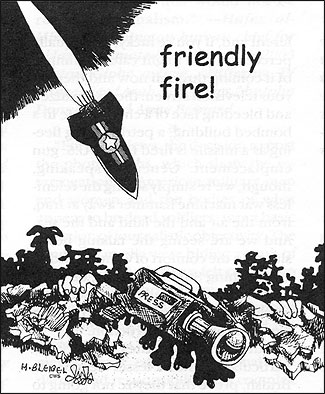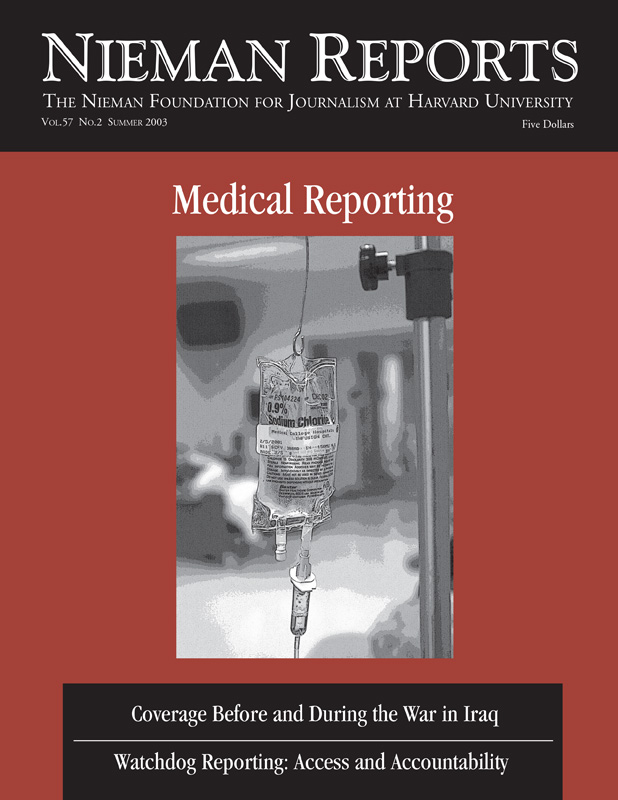This article appeared in The Daily Star on March 25, 2003, written by Rami G. Khouri, executive editor of The Daily Star, an English-language newspaper in Beirut, Lebanon. Khouri is a 2002 Nieman Fellow.

Cartoon by Hassan Bleibel, Beirut, Lebanon. Reprinted by permission of Cartoonists & Writers Syndicate/cartoonweb.com.
The first thing I learned from the early days of the war in Iraq is not to rely solely on either American or Arab satellite/cable television channels as primary sources of news and analysis—but one should also watch both sides to get a complete view of events on the ground and in people’s minds. For different reasons, Arab and American television—with a few notable exceptions that confirm the rule—both broadly provide a distorted, incomplete picture of events while accurately reflecting emotional and political sentiments on both sides.
Every day I scan through 20 different Arab and American TV services. This is a painful exercise, because the business of reporting and interpreting the serious news of war has been transformed into a mishmash of emotional cheerleading, expressions of primordial tribal and national identities, overt ideological manipulation by governments, and crass commercial pandering to the masses in pursuit of the audience share needed to sell advertising.
American television tends to go heavy on the symbols of patriotism, with American flags fluttering as integral elements of on-screen logos or backdrops, while emotional collages of war photos are used liberally as transitions between live reports and advertising breaks. Other signs of how American TV tends to reflect the pro-war sentiments of the government and many in society include the tone of most anchors and hosts, the heavy emphasis on showcasing America’s weapons technology, the preponderance of ex-military men and women guests, not showing the worst civilian casualties in Iraq, highlighting U.S. troops’ humanitarian assistance to Iraqis, and reporters’ and hosts’ use of value-laden and simplistic expressions like “the good guys” to refer to American troops.
The most unfortunate and professionally disgraceful aspect of U.S. television coverage, in my view, has been the widespread double assumption that Iraqis would offer no resistance and would welcome the U.S. Army with open arms. Some Iraqis will surely do so, but most people in this region now see the Americans as an invading force that will become an occupying force. The American media probably reflect widespread American ignorance about what it means to have your country invaded, occupied, administered and retooled in someone else’s image. Americans are correct to assume that their impressive military might will prevail on the battlefield; yet they also appear totally and bafflingly oblivious to the visceral workings of nationalism and national identity. I have seen no appreciation whatsoever in America for the fact that while Iraqis generally may dislike their vicious and violent Iraqi regime, the average Iraqi and Arab has a much older, stronger and more recurring fear of armies that come into their lands from the West carrying political promises and bags of rice.
RELATED ARTICLE
"The Arab Press"
- Excerpts from an article by Rami KhouriArab television channels display virtually identical biases and omissions, including heavy relaying of film of the worst Iraqi civilian casualties, interviews with guests who tend to be critical of the United States, hosts and anchors who often seem to see their role as debating rather than merely interviewing American guests, accepting Iraqi and other Arab government statements at face value without sufficiently probing their total accuracy, and highlighting the setbacks to the attacking Anglo-American forces, by means including showing film of captured or dead troops.
We in the Arab world are slightly better off than most Americans because we can see and hear both sides, given the easy availability of American satellite channels throughout this region; most Americans do not have easy access to Arab television reports and, even if they did, they would need to know Arabic to grasp the full picture.
Two days ago, I better understood the need to see images from both sides. Arab television stations showed pictures of dead and captured American troops, many of which were eventually shown on American television. But Arab channels the same day also showed a horrifying picture that did not get into American TV: a small Iraqi child who had died during an American attack, with the back of the child’s skull and head missing. The picture was as gut-wrenching and disgusting to Arabs as the pictures of the dead Americans were to Americans.
You had to see both images simultaneously that day to fully grasp the three most important dimensions of this conflict, in my view: a) the terrible tragedy of human loss and suffering on both sides; b) that this was a deliberately chosen American war that could and should have been avoided, and c) we have only started to witness the human, economic and political costs that will be paid by many people and countries before this adventure plays itself out.
If you’re getting your news and views from either Arab or American television, it is now very clear: You’re getting only half the story.

Cartoon by Hassan Bleibel, Beirut, Lebanon. Reprinted by permission of Cartoonists & Writers Syndicate/cartoonweb.com.
The first thing I learned from the early days of the war in Iraq is not to rely solely on either American or Arab satellite/cable television channels as primary sources of news and analysis—but one should also watch both sides to get a complete view of events on the ground and in people’s minds. For different reasons, Arab and American television—with a few notable exceptions that confirm the rule—both broadly provide a distorted, incomplete picture of events while accurately reflecting emotional and political sentiments on both sides.
Every day I scan through 20 different Arab and American TV services. This is a painful exercise, because the business of reporting and interpreting the serious news of war has been transformed into a mishmash of emotional cheerleading, expressions of primordial tribal and national identities, overt ideological manipulation by governments, and crass commercial pandering to the masses in pursuit of the audience share needed to sell advertising.
American television tends to go heavy on the symbols of patriotism, with American flags fluttering as integral elements of on-screen logos or backdrops, while emotional collages of war photos are used liberally as transitions between live reports and advertising breaks. Other signs of how American TV tends to reflect the pro-war sentiments of the government and many in society include the tone of most anchors and hosts, the heavy emphasis on showcasing America’s weapons technology, the preponderance of ex-military men and women guests, not showing the worst civilian casualties in Iraq, highlighting U.S. troops’ humanitarian assistance to Iraqis, and reporters’ and hosts’ use of value-laden and simplistic expressions like “the good guys” to refer to American troops.
The most unfortunate and professionally disgraceful aspect of U.S. television coverage, in my view, has been the widespread double assumption that Iraqis would offer no resistance and would welcome the U.S. Army with open arms. Some Iraqis will surely do so, but most people in this region now see the Americans as an invading force that will become an occupying force. The American media probably reflect widespread American ignorance about what it means to have your country invaded, occupied, administered and retooled in someone else’s image. Americans are correct to assume that their impressive military might will prevail on the battlefield; yet they also appear totally and bafflingly oblivious to the visceral workings of nationalism and national identity. I have seen no appreciation whatsoever in America for the fact that while Iraqis generally may dislike their vicious and violent Iraqi regime, the average Iraqi and Arab has a much older, stronger and more recurring fear of armies that come into their lands from the West carrying political promises and bags of rice.
RELATED ARTICLE
"The Arab Press"
- Excerpts from an article by Rami KhouriArab television channels display virtually identical biases and omissions, including heavy relaying of film of the worst Iraqi civilian casualties, interviews with guests who tend to be critical of the United States, hosts and anchors who often seem to see their role as debating rather than merely interviewing American guests, accepting Iraqi and other Arab government statements at face value without sufficiently probing their total accuracy, and highlighting the setbacks to the attacking Anglo-American forces, by means including showing film of captured or dead troops.
We in the Arab world are slightly better off than most Americans because we can see and hear both sides, given the easy availability of American satellite channels throughout this region; most Americans do not have easy access to Arab television reports and, even if they did, they would need to know Arabic to grasp the full picture.
Two days ago, I better understood the need to see images from both sides. Arab television stations showed pictures of dead and captured American troops, many of which were eventually shown on American television. But Arab channels the same day also showed a horrifying picture that did not get into American TV: a small Iraqi child who had died during an American attack, with the back of the child’s skull and head missing. The picture was as gut-wrenching and disgusting to Arabs as the pictures of the dead Americans were to Americans.
You had to see both images simultaneously that day to fully grasp the three most important dimensions of this conflict, in my view: a) the terrible tragedy of human loss and suffering on both sides; b) that this was a deliberately chosen American war that could and should have been avoided, and c) we have only started to witness the human, economic and political costs that will be paid by many people and countries before this adventure plays itself out.
If you’re getting your news and views from either Arab or American television, it is now very clear: You’re getting only half the story.



